Santiago Casas, Dr. rer. nat.
Towards a robust exploration of the Dark Sector with Euclid and Stage-IV surveys in the next decade
CosmoStat @ DAp-AIM, CEA Paris-Saclay
May 29th 2024
Interview Presentation



santiagocasas www.santicasas.xyz @sant87casas




Outline of the talk
-
Theoretical physicist and cosmologist, broad background, deep interests:
- computational physics, numerical methods, statistics, data analysis.
- computational physics, numerical methods, statistics, data analysis.
- Comprehensive and holistic understanding of the Euclid mission
- 10 years at forefront of Inter-Science-Working-Groups
- Competitive edge to exploit scientific content of the data and enable physical discoveries
- Extensive experience in supervision of research projects
- My skillset aligns, complements and potentiates fields of research of CosmoStat
- Can help CosmoStat/DAp lead and be at forefront of analysis of next generation cosmological experiments
2006-2010
B.Sc. Physics
Universidad de Costa Rica
2011-2013
M.Sc. Physics
University of Heidelberg
2013-2017
PhD Physics, University of Heidelberg, Institute of Theoretical Physics
2018-2021
Postdoctoral Researcher,
CosmoStat, CEA Paris-Saclay
2021-2024
Postdoctoral Researcher, Theoretische Teilchenphysik und Kosmologie,
RWTH Aachen U.
2024-
Postdoctoral Researcher,
Institute of Cosmology and Gravitation, U. Portsmouth
3 Months Internship
Laboratorio Nacional de Luz Sincrotron,
Campinas, Brazil
3 Months stance:
University of Geneva, M. Kunz, 2015
Tonale Winter School of Cosmology Organizer 2016-2021
2006-2010
B.Sc. Physics
Universidad de Costa Rica
3 Months Internship
Laboratorio Nacional de Luz Sincrotron,
Campinas, Brazil

Sirius: Largest LATAM Synchrotron

Tosin, Basilio, Casas, Marcondes, PAC 09, (2010)


Assistant for the department of Theoretical Physics: Prof. Max Chaves.
Topics: Geometrical
Algebra
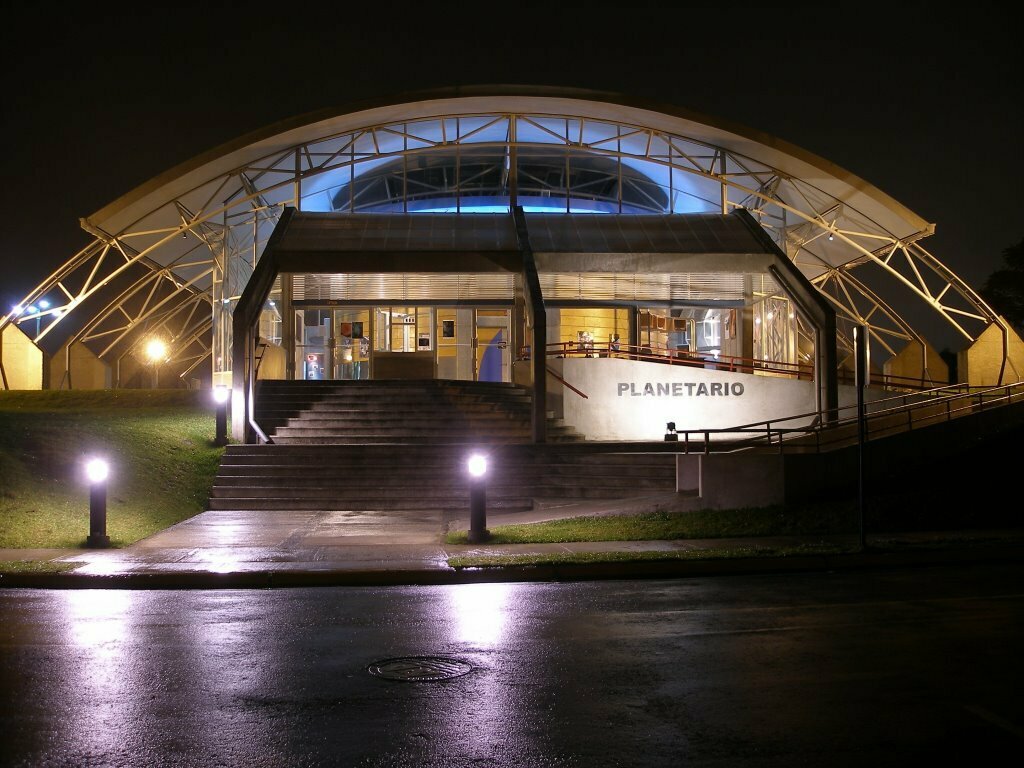
Assistant for the Planetarium of San José.
Astronomy
Solar Physics
B.Sc. Assistant Lecturer for General Physics II and Physics for Life Sciences
2006-2010
B.Sc. Physics
Universidad de Costa Rica
2011-2013
M.Sc. Physics
University of Heidelberg
2013-2017
PhD Physics, University of Heidelberg, Institute of Theoretical Physics
2018-2021
Postdoctoral Researcher,
CosmoStat, CEA Paris-Saclay
Postdoctoral Researcher, Theoretische Teilchenphysik und Kosmologie,
RWTH Aachen U.
2024-
Postdoctoral Researcher,
Institute of Cosmology and Gravitation, U. Portsmouth
3 Months Internship
Laboratorio Nacional de Luz Sincrotron,
Campinas, Brazil
3 Months stance:
University of Geneva, M. Kunz, 2015
Tonale Winter School of Cosmology Organizer 2016-2021
2021-2024
2011-2013
M.Sc. Physics
University of Heidelberg
Ministry of Science Scholarship, MICIT, CR
Oldest University in Germany (1386) Top 3 in Physics
Top 50 in the world


Focus Fields:
Theoretical Physics
QFT
GR
Cosmology
Inspiring professors:
Theoretical Astrophysics, Prof. Bartelmann
Computatonal Physics, Prof. Volker Springel
Neuroscience
Assistant job:
Max-Planck Institute of Medicine
Tutor of:
GR, Cosmo, Theoretische Mechanik, Elektrodynamik
github.com/knossos-project/knossos
Master thesis project. Supervisors Prof. Luca Amendola, Dr. Marco Baldi. Fitting and forecasting non-linear coupled Dark Energy
Casas, Amendola, Baldi, et al; JCAP (2016), 1508.07208.
2006-2010
B.Sc. Physics
Universidad de Costa Rica
2011-2013
M.Sc. Physics
University of Heidelberg
2013-2017
PhD Physics, University of Heidelberg, Institute of Theoretical Physics
2018-2021
Postdoctoral Researcher,
CosmoStat, CEA Paris-Saclay
Postdoctoral Researcher, Theoretische Teilchenphysik und Kosmologie,
RWTH Aachen U.
2024-
Postdoctoral Researcher,
Institute of Cosmology and Gravitation, U. Portsmouth
3 Months Internship
Laboratorio Nacional de Luz Sincrotron,
Campinas, Brazil
3 Months stance:
University of Geneva, M. Kunz, 2015
Tonale Winter School of Cosmology Organizer 2016-2021
2021-2024
2013-2017
Ph.D., U. Heidelberg Institute of Theoretical Physics
Joined Euclid Consortium
2014,
Theory Working Group
Joined
Euclid Interscience
Taskforce on Forecasting (IST:F), main contributor
Supervisor: Prof. Valeria Pettorino, Prof. Luca Amendola.
Second reader: Prof. Volker Springel.
Non-linear Structure formation in models of Modified Gravity and Dark Energy
Grade: Summa Cum Laude
Participant and organizer of Tonale Winter School on Cosmology 2012-2021

Stance in U. Geneva with Prof. M. Kunz.
Forecasts for Euclid, DESI, SKA in Modified Gravity. Casas et al, (2017) 1703.01271
Project on relativistic N-bodys for Growing Neutrino Quintessence. Casas, Pettorino, Wetterich (2016); 1608.02358
Speaker at the invitation-only workshop on Gravity @ Ringberg Castle, Germany.
Boltzmann Solver interface
Fisher Matrix Code:

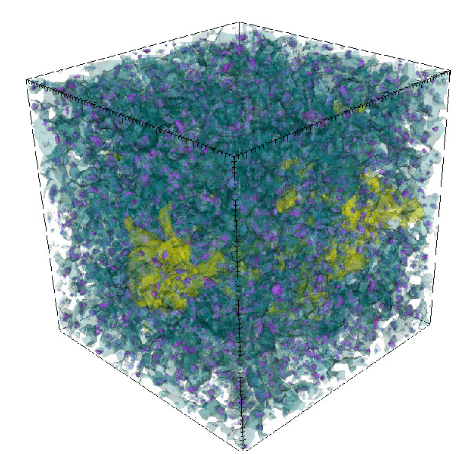
2006-2010
B.Sc. Physics
Universidad de Costa Rica
2011-2013
M.Sc. Physics
University of Heidelberg
2013-2017
PhD Physics, University of Heidelberg, Institute of Theoretical Physics
2018-2021
Postdoctoral Researcher,
CosmoStat, CEA Paris-Saclay
Postdoctoral Researcher, Theoretische Teilchenphysik und Kosmologie,
RWTH Aachen U.
2024-
Postdoctoral Researcher,
Institute of Cosmology and Gravitation, U. Portsmouth
3 Months Internship
Laboratorio Nacional de Luz Sincrotron,
Campinas, Brazil
3 Months stance:
University of Geneva, M. Kunz, 2015
Tonale Winter School of Cosmology Organizer 2016-2021
2021-2024
Finalization of the IST:F effort. Blanchard et al (2019); A&A, 1910.09273
Euclid STAR prize Team co-winner.
STAR Prize PhD nomination.
EC Helsinki STAR prize plenary talk.
Co-organizer of Tonale Winter School on Cosmology 2018-2021
Start of the IST:Likelihood effort.
Joined as expert, reviewer and developer.
Python/SciPy/Numpy
Tutorials with Sam Farrens:
github.com/CosmoStat/Tutorials
Learning slots on variety of topics from ML to Einstein-Boltzmann-solvers
Start Development of
CosmicFishPie and Emulators
- 2019-2024 Co-Lead of the Euclid Theory Working Group Work Package 6: Forecasts for Beyond-LCDM Models.
- WP6: 4 Publications, first author 2306.11053, main contributor and co-lead: 2306.12368, + 2 under internal review


2018-2021
Postdoctoral Researcher
AIM/DAp, CEA Paris-Saclay
Supervision of two interns:
Raphael Baena
Senwen Deng
EC IST:F Paris meeting co-organizer
Selected as Theory Working Group WP6 (Forecasting) co-lead with V. Pettorino and I. Tutusaus
Jax Cosmo collaboration with F. Lanusse
github.com/DifferentiableUniverseInitiative/jax_cosmo

Joined SKAO Cosmology Science Working Group
Founding member of alpha-CEN. Astrophysics org. for Central America.
Publications with AIM affiliation:
2018: 4 papers
2019: 4 papers, 2 Euclid papers
2020: 2 papers, 7 Euclid papers
2021: 7 Euclid papers

2006-2010
B.Sc. Physics
Universidad de Costa Rica
2011-2013
M.Sc. Physics
University of Heidelberg
2013-2017
PhD Physics, University of Heidelberg, Institute of Theoretical Physics
2018-2021
Postdoctoral Researcher,
CosmoStat, CEA Paris-Saclay
Postdoctoral Researcher, Theoretische Teilchenphysik und Kosmologie,
RWTH Aachen U.
2024-
Postdoctoral Researcher,
Institute of Cosmology and Gravitation, U. Portsmouth
3 Months Internship
Laboratorio Nacional de Luz Sincrotron,
Campinas, Brazil
3 Months stance:
University of Geneva, M. Kunz, 2015
Tonale Winter School of Cosmology Organizer 2016-2021
2021-2024
Work in the group of Prof. J. Lesgourgues, epicenter of neutrino cosmology
Submitted projects for the RWTH High Performance Computing Center.
More than 1 Mio CPU-hours granted.
Tutor of : General Relativity, Advanced Cosmology, Theoretische Mechanik
Development of CosmicFish/MontePython, CLASS/CAMB validation for Euclid photometric and spectroscopic probes. Casas et al., (2023), A&A,
Release of upgraded CosmicFishPie
- 2019-2024 Co-Lead of the Euclid Theory Working Group Work Package 6: Forecasts for Beyond-LCDM Models.
- WP6: 4 Publications, first author 2306.11053, main contributor and co-lead: 2306.12368, + 2 under internal review


Supervision of 5 Master students (12 months each) and 2 Bachelor students.
4 Euclid publications as Leader of TWG Work Package 6. 1 as first author: Casas et al (2023), 2306.11053.
Release of updated MontePython Euclid likelihoods:
github.com/brinckmann/montepython_public
EC meeting Copenhagen:
Euclid Builder Status achieved
Start of IST:Nonlinear.
Key Paper co-lead in 3x2pt photometric.
Publications with TTK:
2021: 2 reviews, 3 EC papers
2022: 1 paper, 11 EC papers
2023: 1 paper, 20 EC papers
2024: 3 papers, 18 EC papers
Postdoctoral Researcher, Theoretische Teilchenphysik und Kosmologie,
RWTH Aachen U.
2021-2024

CLASS-1loop project. Accurate nonlinear modeling for spectroscopic Galaxy Clustering in redshift space
Linde et al (2024), JCAP, 2402.09778
First accurate and validated Euclid primary probes MCMC forecasts for Neutrino Sensitivity:
Archidiacono, Lesgourgues, Casas, et al. 2405.06047


Euclidean Timeline
Joined Inter-SWG-Taskforce on Forecasting (IST:F)
2015

IST:F STAR prize co-winner, plenary talk
2019

2019

Member of IST:Likelihood core-team
2019
Core member of IST:Nonlinear develop team
2019


Selected coordinator of Key Project TH-1
2021
KP-JC6 and IST:NL Key-paper co-lead
2022
Become EC member, Theory Science Working Group (TH-SWG)

2014


Joined EC Internal COM group
2023

EC Copenhagen: Achieved Builder Status
2023

EC Rome: Plenary Speaker
2024

TH-SWG WP17 Likelihood co-lead
2024

Lead Data Release 1 Key project
Coordination or Committee lead


Selected as TH-SWG Work Package 6 Forecasting co-lead

nomination STAR prize PhD
2018

Euclid
ESA class M2, 6 years nominal mission
Credits: www.esa.int/Science_Exploration/Space_Science/Euclid, www.euclid-ec.org, ESA/NASA/SpaceX, Euclid Consortium, ThalesAlenia Space
Sun-Earth Lagrange point 2, 1.5 million km from Earth





EC scientist visits Cannes

The EC fingertip galaxy, credits: Lisa Pettibone

The instruments


Launched 1st July 2023 with a SpaceX Falcon9 rocket
More than ~2500 members
Euclid Instruments
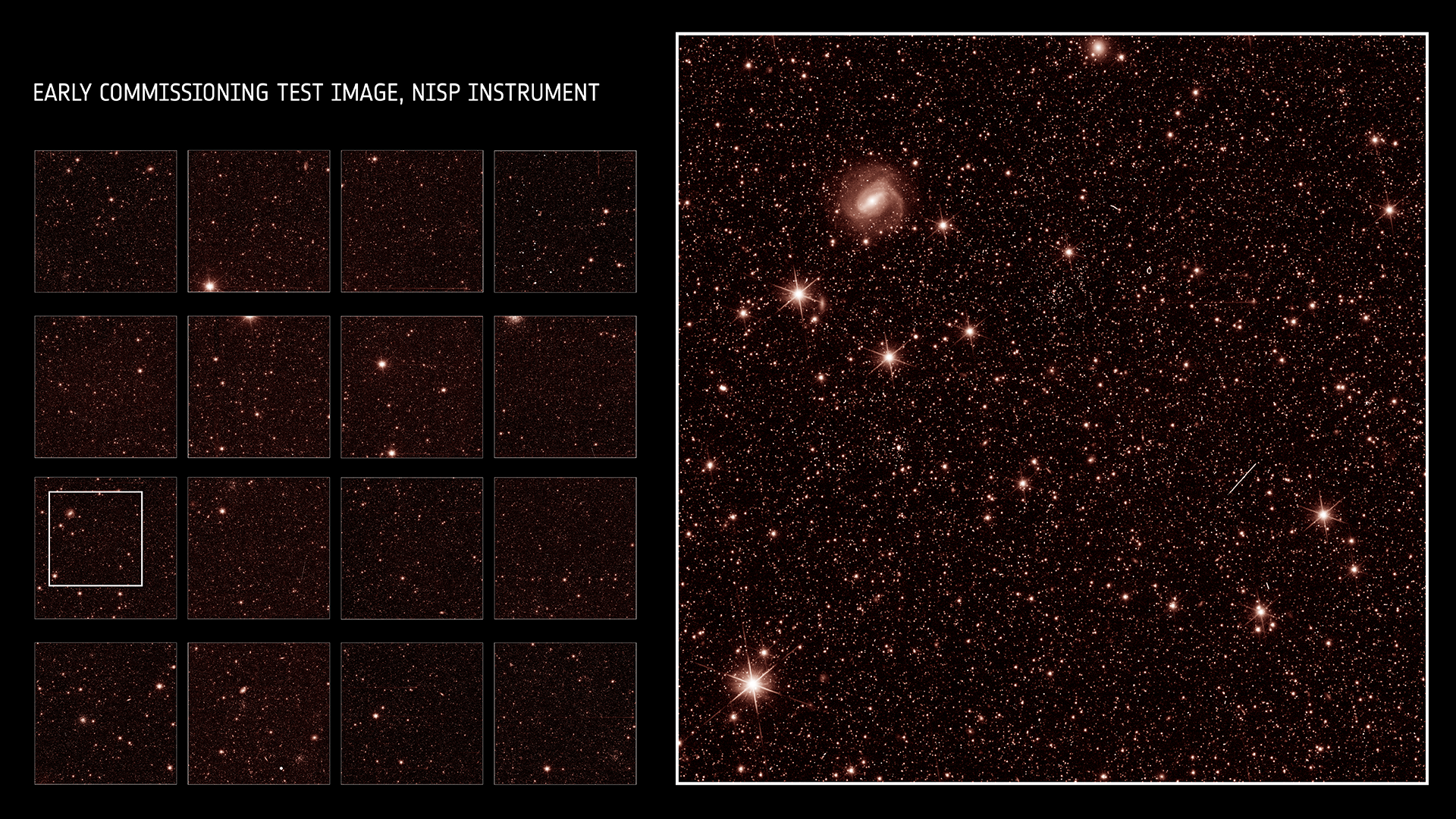
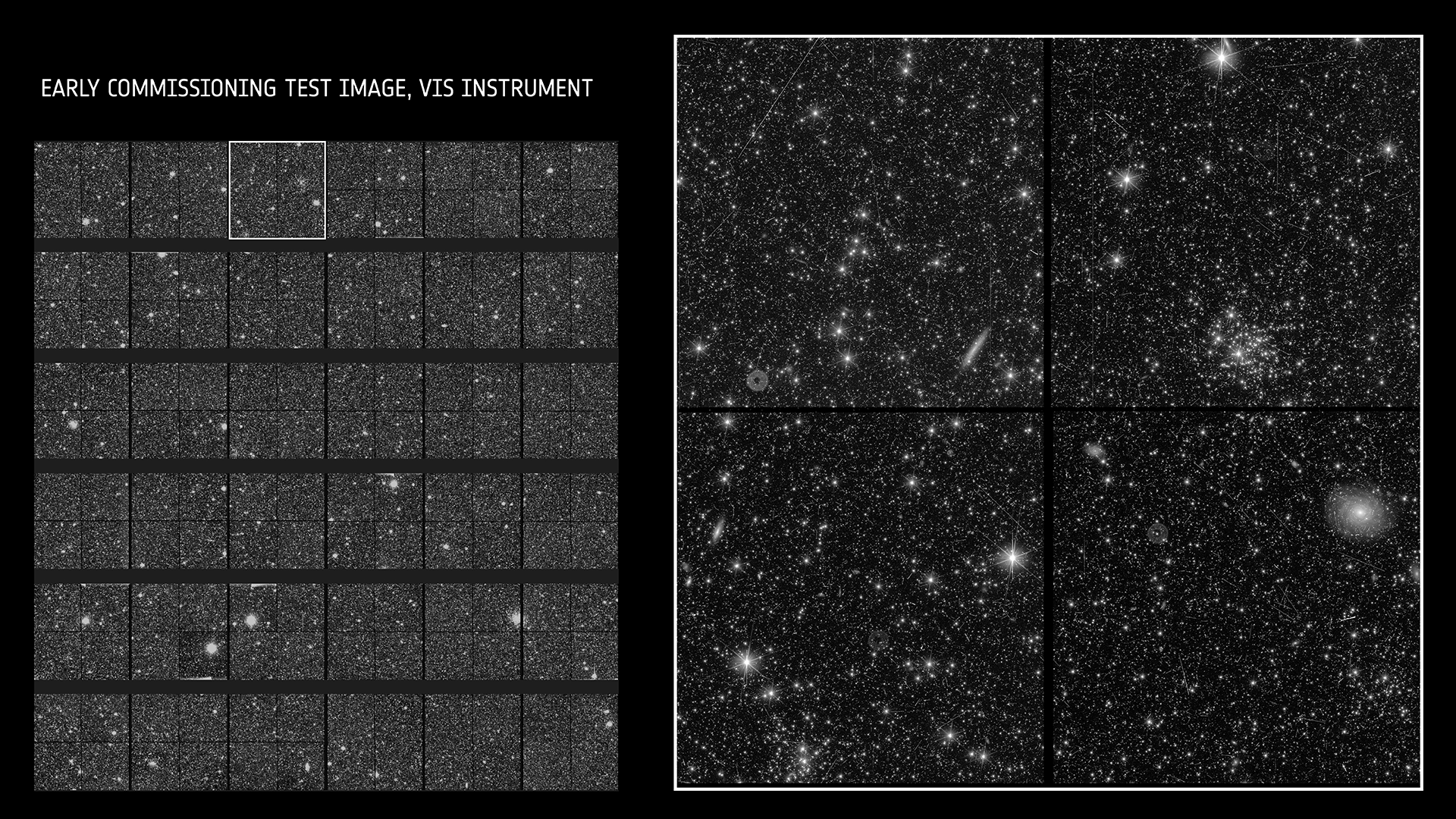
NISP
Near-Infrared Spectrometer and Photometer
VIS Instrument
Visible Camera
https://www.esa.int/Science_Exploration/Space_Science/Euclid/Euclid_test_images_tease_of_riches_to_come
Theory
Observables
Simulations
The pillars of cosmology
What are the primary observables of Euclid?
Galaxy Clustering

Express the excess probabilty of finding another galaxy as a function of scale


Euclid: Fast two-point correlation function covariance through linear construction, Keihänen et al. (2022)
Weak Lensing


angular space power spectrum of the auto-correlation of galaxy ellipticities
Euclid. I. Overview of the Euclid mission, Euclid collaboration, Mellier et al., 2405.13491. Plot credit: N. Tessore.
Weak Lensing

tomography: multiple redshift bins and their cross-correlations
\(z\)



Euclid. I. Overview of the Euclid mission, Euclid collaboration, Mellier et al., 2405.13491. Plot credit: N. Tessore.
How does my work contribute to those observables?
The matter power spectrum
Galaxy Clustering and Weak Lensing ultimately probe the matter power spectrum
Gives us information on how matter species have clustered over the history of the Universe as a function of scale and time
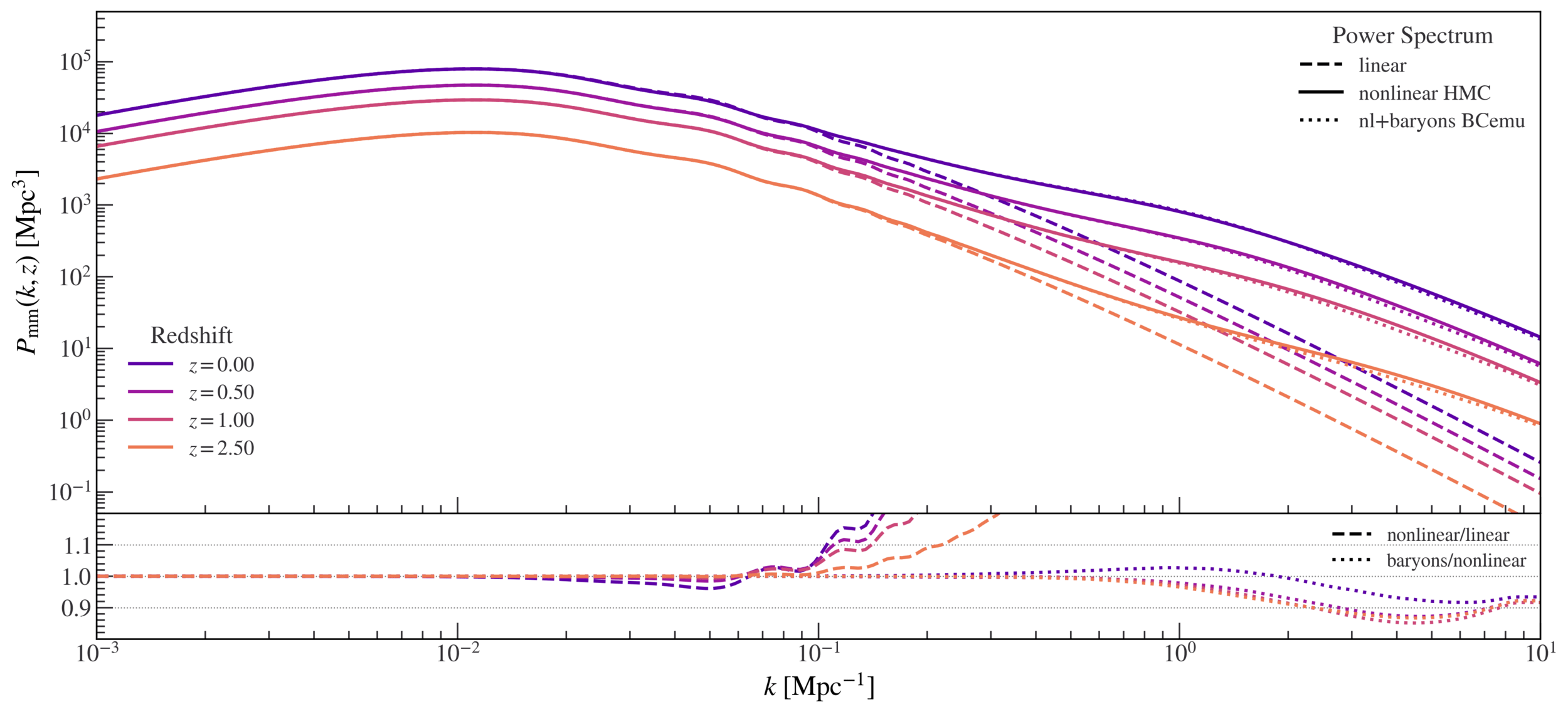
The matter power spectrum
Expertise on all the different scales

The matter power spectrum
Expertise on all the different scales

- Linear perturbations: Einstein-Boltzmann-Solvers: CAMB, CLASS, MGCAMB, EFTCAMB, HiCLASS
- 21cm IM, CMB
- Inflation, isocurvature
The matter power spectrum

Expertise on all the different scales
- Spectroscopic Galaxy Clustering
- 1-loop perturbation theory
- BAO damping
- Redshift-space-distortions
- Neutrinos
- Linear perturbations: Einstein-Boltzmann-Solvers: CAMB, CLASS, MGCAMB, EFTCAMB, HiCLASS
- 21cm IM, CMB
- Inflation, isocurvature
The matter power spectrum
- Linear perturbations: Einstein-Boltzmann-Solvers: CAMB, CLASS, MGCAMB, EFTCAMB, HiCLASS
- 21cm IM, CMB
- Inflation, isocurvature
- Weak Lensing and 3x2photo
- Halofit, HMCode, Emulators
- Baryonic feedback
- N-body simulations

Expertise on all the different scales
- Spectroscopic Galaxy Clustering
- 1-loop perturbation theory
- BAO damping
- Redshift-space-distortions
- Neutrinos
The matter power spectrum
- Fork github.com/santiagocasas/MGCAMB in f(R):
Casas+2306.11053 - SKA x Euclid synergy:
Casas+2210.05705 - Higgs-dilaton inflation+Dark Energy: Casas+1712.04956
- CLASS 1-loop: Linde+2402.09778
- Gaussian streaming in RSD:
Bose+1911.04391 - Sensitivity to Neutrinos:
Archidiacono, Lesgourgues, Casas+
+2405.06047
- Stage-IV Forecasts for non-linear DE: Casas+1703.01271
- Relativistic N-body, GNQ: Casas+
1608.02358 - Fitting functions from f(R) Nbody: Winther, Casas+1903.08798
selected
publications:
Expertise on all the different scales

What is the main theoretical question driving my passion for research?

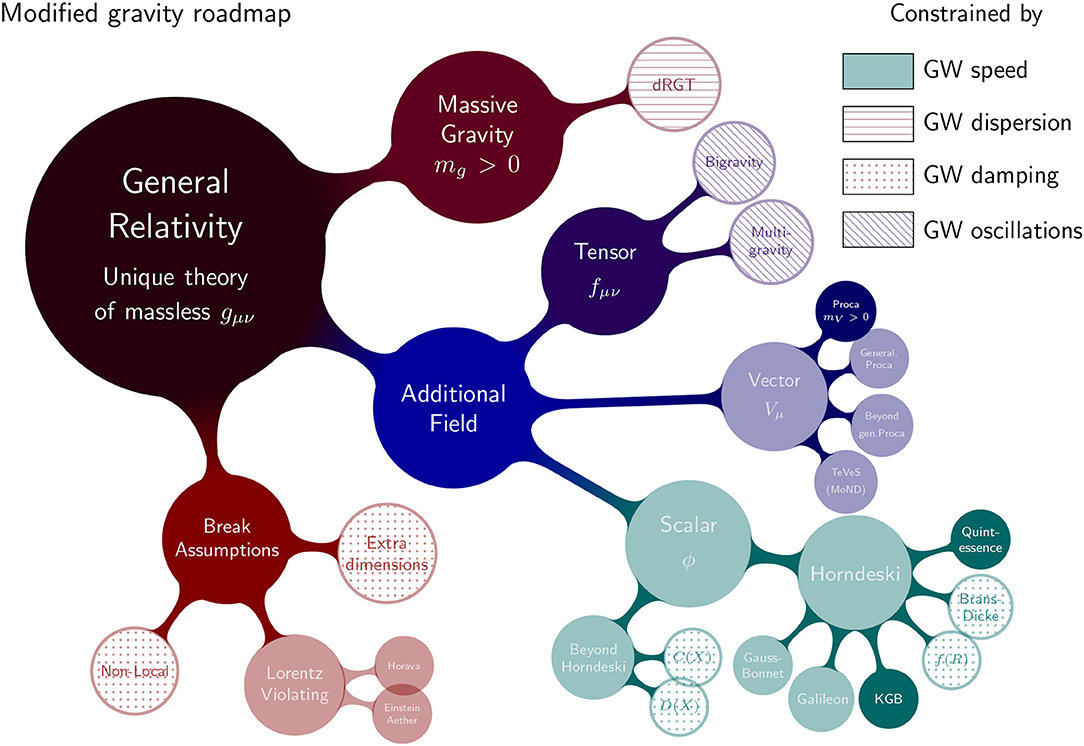
Ezquiaga, Zumalacárregui, Front. Astron. Space Sci., 2018
Is there something beyond
General Relativity that can explain cosmic acceleration?
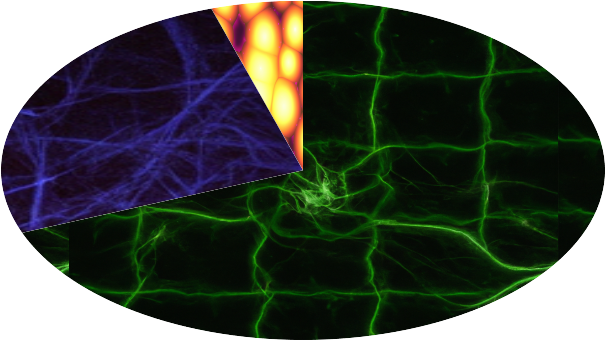
68% Dark Energy
5% Baryons
27% Dark Matter
- What is \(\Lambda\) ?
- What is CDM ?

Ezquiaga, Zumalacárregui, Front. Astron. Space Sci., 2018

68% Dark Energy
5% Baryons
27% Dark Matter
- What is \(\Lambda\) ?
- What is CDM ?
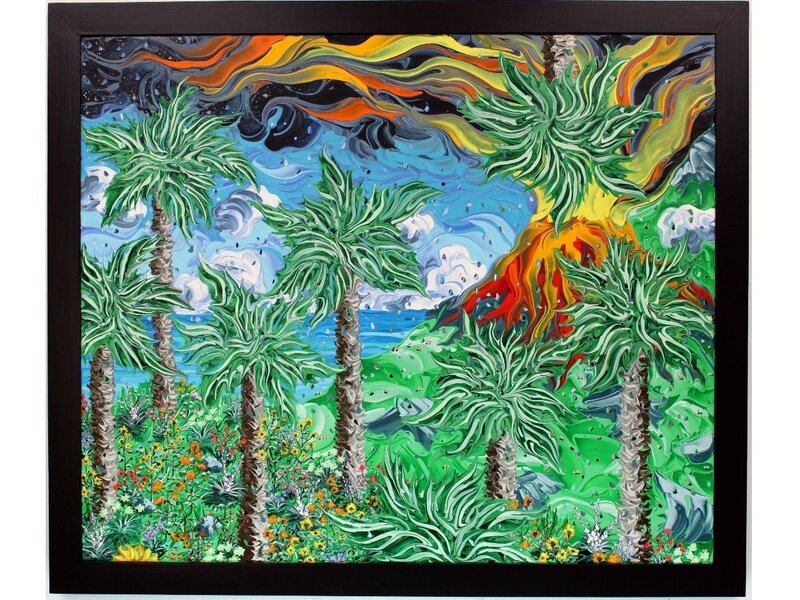
Gregory Horndeski
https://www.horndeskicontemporary.com/works

Is there something beyond
General Relativity that can explain cosmic acceleration?

DESI cosmological results (2024)
What makes Stage-IV galaxy surveys particularly well-suited for testing Modified Gravity?
Modified Gravitational Potentials
We can describe general modifications of gravity (of the metric) at the linear perturbation level with 2 functions of scale (\(k\)) and time (\(a\))

We can describe general modifications of gravity (of the metric) at the linear perturbation level with 2 functions of scale (\(k\)) and time (\(a\))

Modified Gravitational Potentials
Euclid primary observables
We can describe general modifications of gravity (of the metric) at the linear perturbation level with 2 functions of scale (\(k\)) and time (\(a\))


Modified Gravitational Potentials
Casas, Kunz, Martinelli, Pettorino (2017); Phys.Dark Univ. 18 1703.01271
Euclid primary observables
Lensing and Clustering
very complimentary probes
We can describe general modifications of gravity (of the metric) at the linear perturbation level with 2 functions of scale (\(k\)) and time (\(a\))

Euclid primary observables

Casas, Kunz, Martinelli, Pettorino (2017); Phys.Dark Univ. 18 1703.01271
Updated forecasts for SKAO, LSST(Rubin), DESI :
Casas, Carucci, Pettorino, Camera, Martinelli (2023); Phys. Dark Univ., 2210.05705;
Modified Gravitational Potentials
Lensing and Clustering
very complimentary probes
We can describe general modifications of gravity (of the metric) at the linear perturbation level with 2 functions of scale (\(k\)) and time (\(a\))

Lensing mass, sensitive to \(\Phi + \Psi\)
Pizzutti, Saltas, Casas et al., Future constraints on the gravitational slip with the mass profiles of galaxy clusters (2017); 1901.01961
Modified Gravitational Potentials
Testing gravity with galaxy clusters
Dynamical mass, sensitive to \(\Psi\)

Recurring Challenge: Modified Gravity in the nonlinear regime

Credit: CoDECS simulations
Simulations of MG are
expensive, need for fitting functions or Emulators.
Baldi (2011);
Casas+(2015) 1508.07208; Winther, Casas+ (2019)1903.08798
Recurring Challenge: Modified Gravity in the nonlinear regime


Credit: CoDECS simulations
Simulations of MG are
expensive, need for fitting functions or Emulators.
Baldi (2011);
Casas+(2015) 1508.07208; Winther, Casas+ (2019)1903.08798
Credits: Yun Ling
CONCEPT forecasts,
Ling, Casas, Dakin, in prep.
Are neutrino suppressions degenerate with MG enhancements?
Peel+(2018)
What about baryons??
Euclid standard project: f(R)+Mnu
Casas, Parimbelli in prep.
Recurring Challenge: Modified Gravity in the nonlinear regime


Credit: CoDECS simulations
Simulations of MG are
expensive, need for fitting functions or Emulators.
Baldi (2011);
Casas+(2015) 1508.07208; Winther, Casas+ (2019)1903.08798
Credits: Yun Ling
CONCEPT forecasts,
Ling, Casas, Dakin, in prep.
Are neutrino suppressions degenerate with MG enhancements?
Peel+(2018)
What about baryons??
Euclid standard project: f(R)+Mnu
Casas, Parimbelli in prep.
Is the fifth force screened at Halo, Clusters and galaxy level?
Different types of screening:
Chameleon, Damour-Polyakov, K-mouflage, Vainshtein
Review: Testing Screened Modified Gravity; Brax, Casas, Desmond, Elder (2021), 2201.10817.
Can we compute very nonlinear dynamics that backreacts into the Friedmann equation?

Growing Neutrino Quintessence,
Casas, Pettorino, Wetterich (2016), Phys. Rev. D 1608.02358
Theory
Observables
Simulations
The four pillars of cosmology
Theory
Observables
Simulations
The four pillars of cosmology
Statistics
Likelihoods: Or how to test a model against (synthetic) data
Bayes Theorem:
Gaussian Likelihood:
Fisher Matrix:
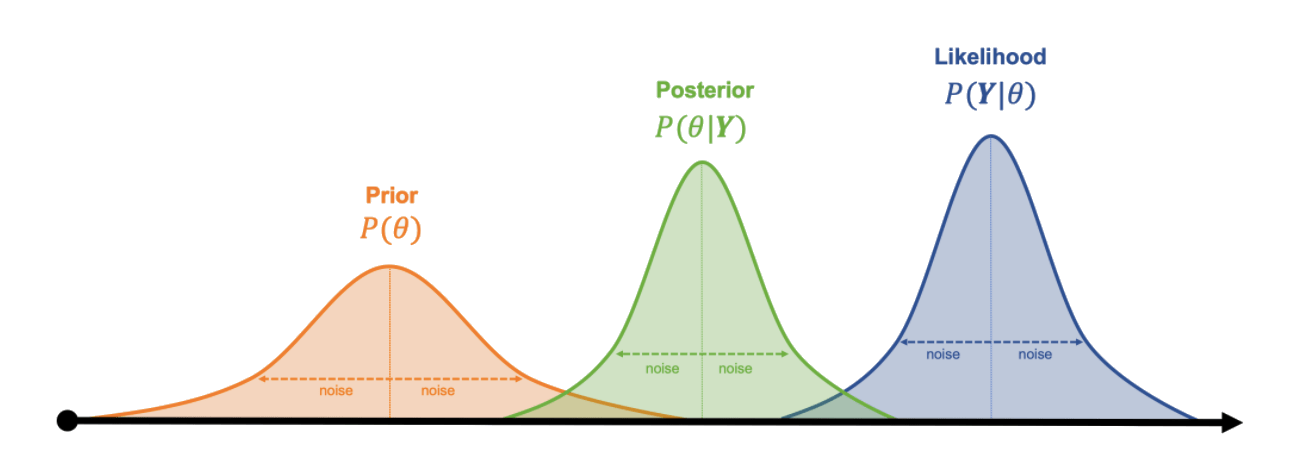
Forecasting the constraining power of Euclid and other Stage-IV surveys
Code: CosmicFishPie
S. Casas, M. Martinelli and M. Raveri
S. Pamuk, Sabarish V.M. and friends
github.com/santiagocasas/cosmicfishpie

New pythonic version: I have been main developer on forecasts for:
SKAO (21cm IM), DESI (GCsp), Vera Rubin LSST (3x2photo), Euclid (GCsp+3x2photo), CMB (TT+TE+EE)

Fisher matrix for the photometric 3x2pt observable in angular space
IST:Forecasting

- Current bounds from CMB and LSS alone
- \(\mathcal{O}(1)\) for {\(w_0\), \(w_a\)} combining Planck+BAO+WL+SNIa
- {\(\mathcal{O}(0.01)\), \(\mathcal{O}(0.1)\)} with Euclid

Awardees of the Euclid STAR Prize Team 2019


Euclid preparation: VII. Forecast validation for Euclid cosmological probes, Blanchard et al. arXiv:1910.09273
I had the honor to present the plenary STAR prize talk in Helsinki 2019.
IST:Forecasting
Recipe, comparison and final Fisher matrices.
One of the few validated Galaxy Clustering + Weak Lensing codes
My main contributions:
Euclid preparation: VII. Forecast validation for Euclid cosmological probes, Blanchard et al. arXiv:1910.09273



Figure of Correlation (FoC), based on:
Casas et al, (2017) Phys. Dark Univ. 1703.01271
Maintainer of public repository.

Plotting scripts for all the figures.
submission to the arXiv
CosmicFish in the beyond-\(\Lambda\)CDM sea

Casas, Rubio, Pauly et al., 1712.04956
Higgs-Dilaton inflation: early-late Universe connection
Constraints on Hu-Sawicki \( f(R)\)

Casas, Amendola, Baldi, Pettorino et al., 1508.07208
Coupled Quintessence: DM-DE

Surviving Horndeski EFT
Frusciante, Peirone, Casas, Lima, 1810.10521
Modified Gravity with SKA 21cm-IM

Casas, Cardone, Sapone, et al., 2306.11053

Casas, Carucci, Pettorino et al 2210.05705
Atayde, Frusciante, Bose, Casas, Li, 2404.11471

Forecasts for generalized Cubic Galileons
Important: Take decisions, is it worth analyzing with data?
MCMC sampling with MontePython

Are Fishers a good approximation to the posterior?

in presence of neutrinos
- TTK Aachen group: developed Euclid photometric and spectroscopic likelihoods for MontePython.
- Validated likelihoods against CosmicFish Fishers, 4 different settings: CAMB/CLASS.
Euclid: Validation of the MontePython forecasting tools, Casas, Lesgourgues, Schöneberg, et al.; 2303.09451
Euclid: Sensitivity to neutrino parameters , Archidiacono, Lesgourgues, Casas, et al.; 2405.06047
w0waCDM
MCMC sampling with MontePython
First up-to-date MCMC forecasts for Euclid+external probes in presence of neutrinos
- TTK Aachen group: developed Euclid photometric and spectroscopic likelihoods for MontePython.
- Validated likelihoods against CosmicFish Fishers, 4 different settings: CAMB/CLASS.
- MCMC Metropolis-Hastings forecasts to test neutrino sensitivity + CMB + clusters.
- Careful consideration of neutrino effects in solvers.


Euclid: Validation of the MontePython forecasting tools, Casas, Lesgourgues, Schöneberg, et al.; 2303.09451
Euclid: Sensitivity to neutrino parameters , Archidiacono, Lesgourgues, Casas, et al.; 2405.06047
Are we ready for Euclid's first Data Release (DR1)?
An example of the complexity in analyzing and constraining a cosmological model
Doing initial forecasts on \(f(R)\) theory with Fisher Matrix:
Induces changes in the gravitational potentials
Casas, Euclid: Constraints on f(R) cosmologies from the spectroscopic and photometric primary probes, 2306.11053
Free parameter: \(f_{R0}\)
\(\lambda_C =32 \rm{Mpc}\sqrt{|f_{R0}|/10^{-4}}\)
"Fifth-force" scale for cosmological densities
Hu, Sawicki (2007)

\(f_{R0}=(5.0^{+ 0.58}_{-0.52} \times 10^{-6})\)
Euclid constraints photometric 3x2pt + GC spectroscopic:
Use fitting formulas for non-linear matter power spectra:
Winther, Casas+1903.08798
An example of the complexity in analyzing and constraining a cosmological model
Project led by K.Koyama, me and my student Sefa Pamuk



- Fitting formulae not accurate enough against N-body simulations
- Emulators / Halo-model strong differences among each other

- Good agreement between Fisher Matrix (Casas+2023) and MCMCs with MontePython, synthetic data == model
- Synthetic data is FORGE (MG-Arepo) : observe parameter bias in the estimation.


Weak Lensing, 6years Euclid data,
IST:F validated MontePython likelihoods: github.com/Sefa76/photometric_fofR/

Weak Lensing, optimistic, with BCEmu as baryonic-feedback model


- When baryonic feedback parameters are left free, the situation degrades!
- When estimating lower bound on \(\log f_{R0}\) we quickly hit the prior. Contours are far from Gaussian.

- Use Bayes ratios to compute prior-independent bounds.
- Large degeneracy in parameter space between cosmology and baryonic parameters, causes projection-effects.
- Used the PROSPECT (Holm+2023) profiling tool to find the profile likelihood: github.com/AarhusCosmology/prospect_public
We included theoretical errors (Audren+2012) to mitigate biases


Reproducible research!

- Modified Gravity emulators not yet at precision level for Euclid's full statistical power.
- Baryonic feedback -> large degeneracies in parameter space.
- Is baryonic feedback really independent of cosmology (Boost formalism)?
- Priors important but given by simulation ranges and Emulator trainings.
- Need to take into account theoretical errors + Covariance.
- MCMC chains and optimization for maximum likelihood estimation, months of running time.
- Need of better samplers, more efficient, auto-differentiable techniques (JAX-cosmo, see later).
Lessons learnt:
Paper under internal review, on the arXiv soon
Reproducible research!
Supervision of students
- 1 PhD student in Heidelberg:
- Ana Marta Pinho, gravitational slip
- 2 internship students at CEA :
- Senwen Deng, inflation-dark-energy
- Raphael Baena, GP, OT, PCA, emulators.
- 5 Master students at RWTH Aachen (12 months projects each) :
- Sabarish V.M. + Sefa Pamuk on MontePython.
- Dennis Linde + Christian Rademacher: CLASS-1loop.
- Johanna Schafmeister: accuracy-aware emulators
- 2 Bachelor students
- Jakob Kramp: JAX-Variational inference.
- Yun Ling: Neutrino N-body forecasts.
Image credits: Yun Ling, Jeppe Dakin,
CONCEPT code.
Much of this work has been thanks to excellent collaborators and students over the years!
- Model-independent test of the gravitational slip using Gaussian Processes. Amendola, Pinho, Casas (2018), 1805.00027.
- Quintessential αα-attractor inflation: forecasts for Stage IV galaxy surveys, Akrami, Deng, Casas (2020), 2010.15822.
- Looti Emulator: github.com/santiagocasas/looti (GP, PCA, Optimal Transport).
- Euclid: Validation of the MontePython forecasting tools, Casas, Sabarish V.M. +(2023), 2303.09451
- Euclid: Sensitivity to neutrino parameters, Archidiacono, Lesgourgues, Casas, Pamuk (2024), 2405.06047.
- CLASS-OneLoop: Accurate and Unbiased Inference from Spectroscopic Galaxy Surveys, Linde+Rademacher (2024) 2402.09778.
- Bayesian NNs: github.com/schafmeister/bayesian_nn



Students moved on to excellent PhDs
Preparations for Euclid's first Data Release (DR1)
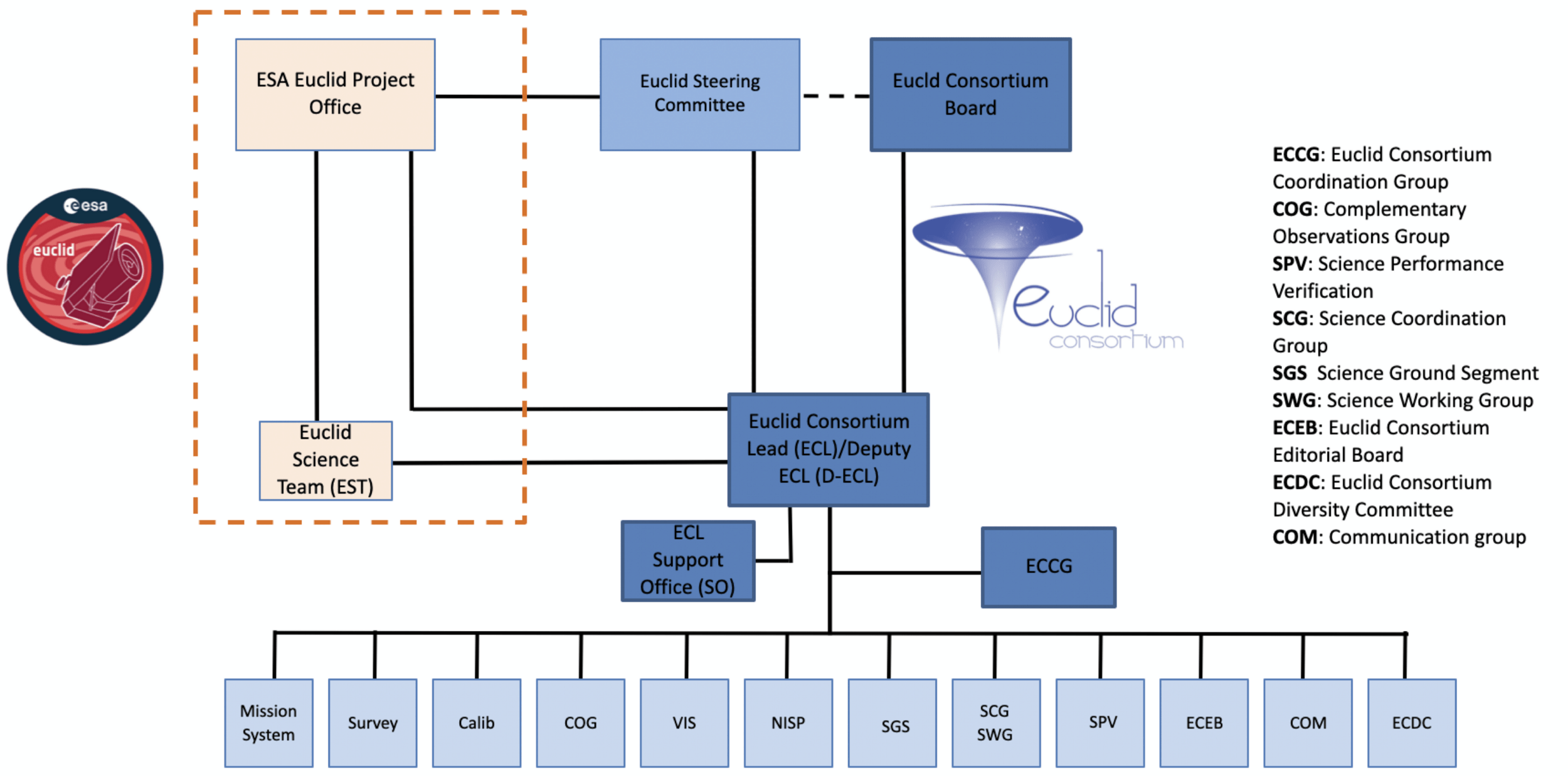
Euclid: A complex project!
Euclid structure: Y. Mellier, with modifications by G. Cañas-Herrera
IST:Likelihood effort
- IST:Likelihood aims at connecting the data products (OU-LE3, J.L. Starck) with the SWG modelling.
- Development of a fully-fledged likelihood code (in Cobaya).
- Joined IST:Likelihood in 2019 as expert/reviewer/developer. Also chain-runner!
- CLOE v2 ready in 2023.
- First MCMC forecasts ready for overview paper.


Euclid. I. Overview of the Euclid mission, Euclid collaboration, Mellier et al., 2405.13491
Image credits: Guadalupe Cañas-Herrera
Convergence for full probe combination achieved after a combined ~ 3 million CPU hours using nested sampling with Polychord
CLOE development

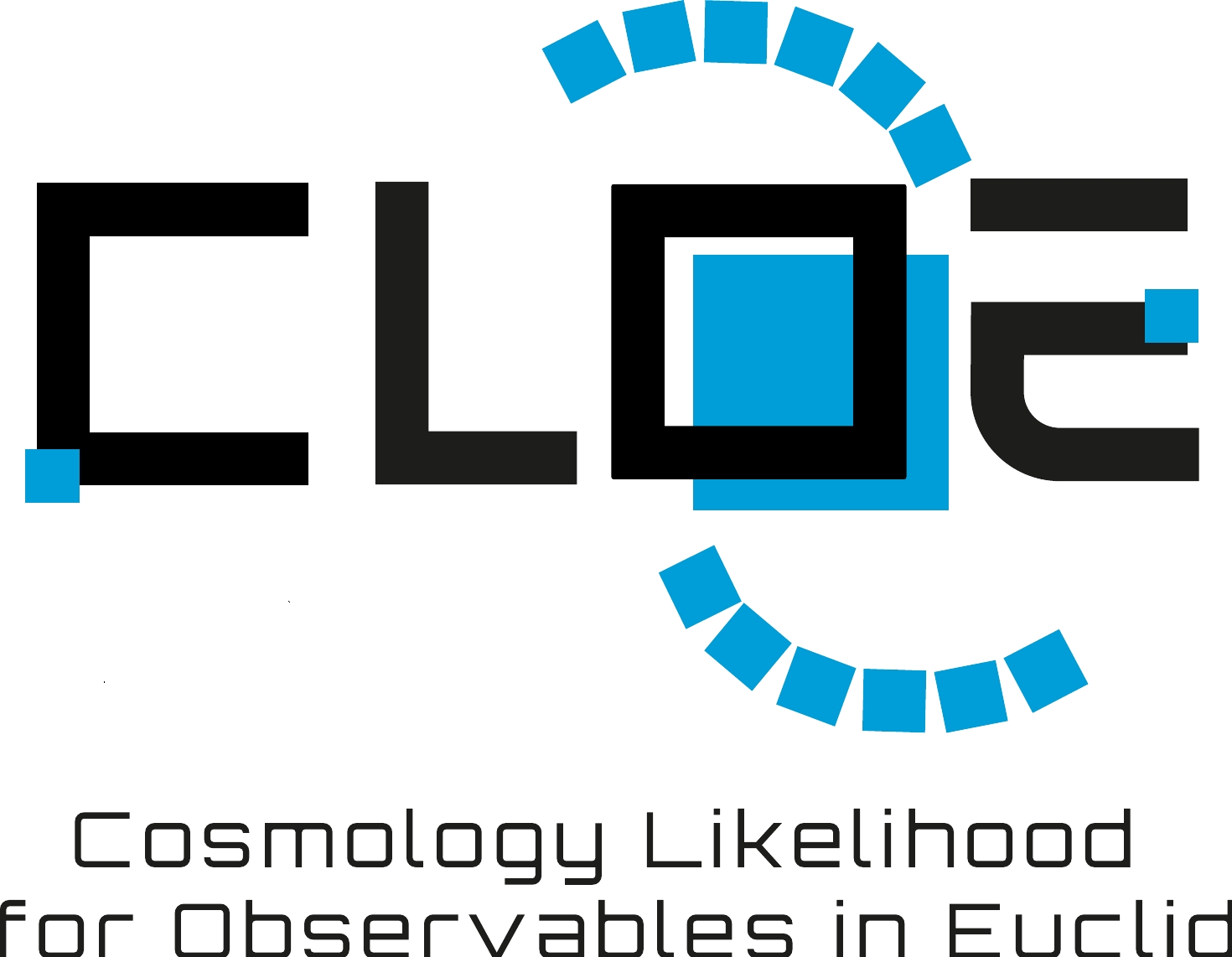


- Complex management. Agile approach developed by V. Pettorino.
- Gitlab boards, continuous integration, automatic testing, sphinx documentation, Docker (thanks S. Farrens)
- After 5 years, more than 1073 completed tasks!
CLOE development




BNT: Half-vectorization technique. In collaboration with S. Camera. IST:Likelihood.
My main contributions:
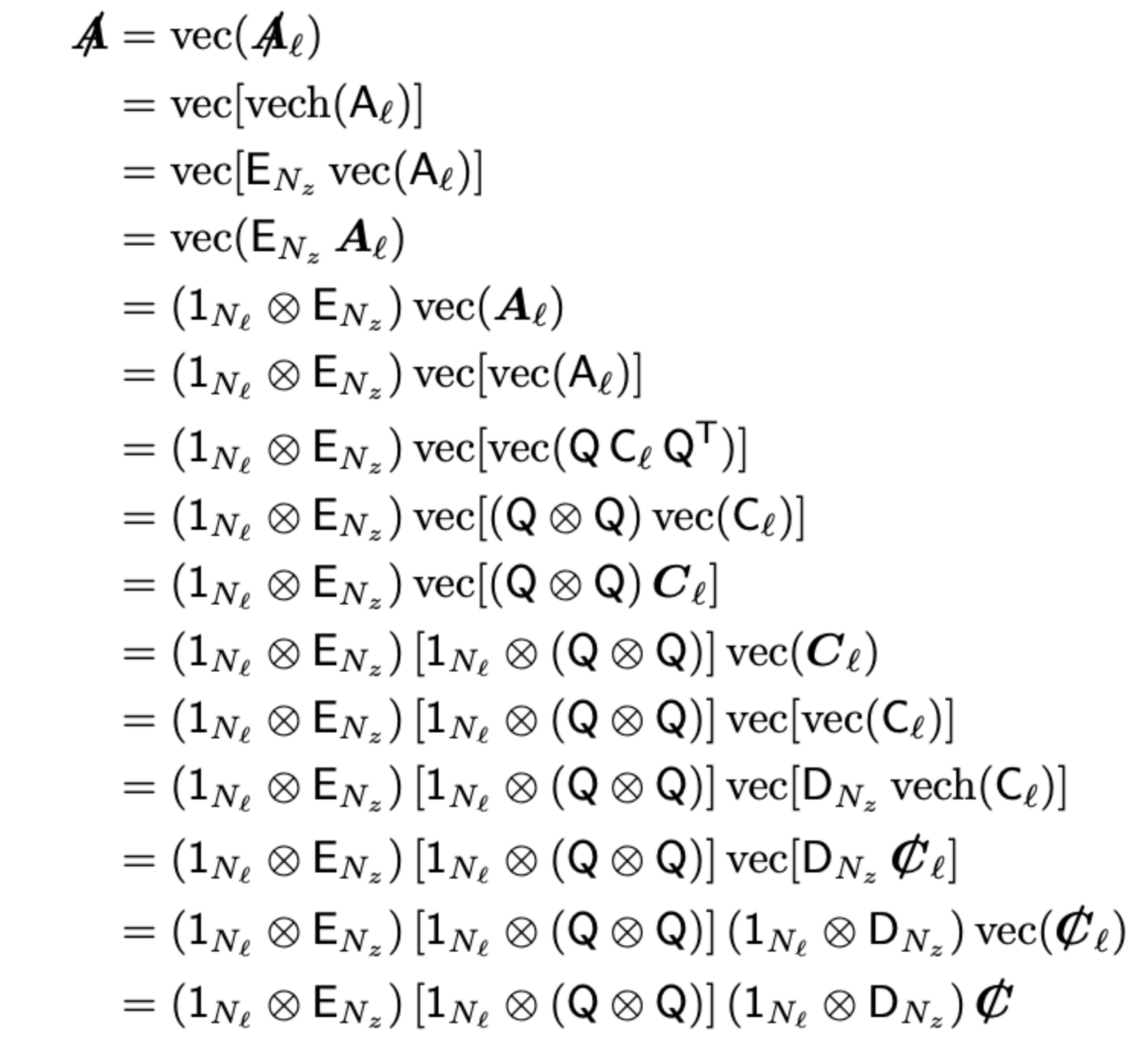
- Complex management. Agile approach developed by V. Pettorino.
- Gitlab boards, continuous integration, automatic testing, sphinx documentation, Docker (thanks S. Farrens)
- After 5 years, more than 1073 completed tasks!
- Bernardeau-Nishimichi-Taruya transform, to perform scale cuts. Developer task.
- Reviewer/expert in Theory.

CLOE development



- Bernardeau-Nishimichi-Taruya transform, to perform scale cuts. Developer task.
- Reviewer/expert in Theory.
- Thanks to techniques learned at CosmoStat,
coder of optimization and speed profiling tasks.
Orders of magnitude improvement. - So-called "Santiago-Matrix" for observable correlations.
- Plotting routines, "FoM polygons".
- Theory WG WP17 (Co-led with G. Cañas-Herrera, I. Tutusaus and S. Ilic): CLOE extensions (rel-corrections, MG, ...)


Image credits: IST:Likelihood team
My main contributions:
- Complex management. Agile approach developed by V. Pettorino.
- Gitlab boards, continuous integration, automatic testing, sphinx documentation, Docker (thanks S. Farrens)
- After 5 years, more than 1073 completed tasks!
Meeting at ESTEC tomorrow!
IST:Nonlinear
- IST:Nonlinear goals:
Developing a robust modelling of non-linear scales. - Primary observables: photometric, spectroscopic


- 2021 started main development.
- I joined the core-development team with weekly hackathons.
- Gitlab repository mirorring IST:L repo (thanks S. Farrens again)
photometric 3x2pt
-
Develop+test Dark Matter power spectrum emulators/fits.
HMCode, Bacco, EuclidEmulator2,... -
Study baryonic feedback with emulator boosts and baryonification:
BCemu, Bacco, HMCode

- I currently run MCMC chains.
- Exploring scale cuts (BNT).
- Parameter bias induced by modelling.
- I am co-leading with P. Carrilho, the 3x2pt Key Paper.
Image credits: P. Carrilho, S. Casas
Euclidean Timeline
Joined Inter-SWG-Taskforce on Forecasting (IST:F)
2015

IST:F STAR prize co-winner, plenary talk
2019

2019

Member of IST:Likelihood core-team
2019
Core member of IST:Nonlinear develop team
2019


Selected coordinator of Key Project TH-1
2021
KP-JC6 and IST:NL Key-paper co-lead
2022
Become EC member, Theory Science Working Group (TH-SWG)

2014


Joined EC Internal COM group
2023

EC Copenhagen: Achieved Builder Status
2023

EC Rome: Plenary Speaker
2024

TH-SWG WP17 Likelihood co-lead
2024

Lead Data Release 1 Key project
Coordination or Committee lead


Selected as TH-SWG Work Package 6 Forecasting co-lead

nomination STAR prize PhD
2018

What are the next steps we need to test cosmology in the era of Big Data?
High-dimensionality problem
- Bottlenecks in current analysis: MCMC sampling inefficiency, large (nuisance) parameter space, maximum likelihood estimation.

EUCLID PRELIMINARY
Weak Lensing
(Cosmic Shear)
+ Baryonic feedback
+ Intrinsic alignment
+ multiplicative bias
+ dnz uncertainties
= 34 parameters
for LCDM flat
Using CLOE Metropolis-Hastings:
6x8 cores x 6 days
Differentiable Universe





jaxcosmo library https://github.com/DifferentiableUniverseInitiative
Campagne, Lanusse, Zuntz, Boucaud, SC, et al, 2302.05163
- Access to exact gradients: efficient samplers and fast optimization.
- Automatic-Differentiation enabled by programming languages/libraries such as JAX, Julia, PyTorch, ...
- Still under-explored in cosmology.
- Jax-Cosmo package an attempt for a fully-differentiable pipeline. Started work 2020 at CosmoStat (F. Lanusse)
- CosmoStat has auto-diff pipelines (see WaveDiff, T. Liaudat, J.L. Starck)
- Great tool for continuous Science Performance Verification (differentiable SPV3 in Euclid?)
- Currently several ideas/projects
in mind with:
Cosmopower-Jax, EBS by Hahn+(2023)
AD-CLASS (RWTH Computer Science collab.)
- June 2023: Invited to Munich Institute for Astro-, Particle and BioPhysics Workshop on Differentiable Programming

Automatic Fisher, Variational Inference, Hamilton-Monte-Carlo
Orders of magnitude faster
Future plans summary and integration at the AIM/DAp
-
Euclid:
- Long term still ~10 years until all data is analyzed!
- OU-LE3 integration with efficient likelihood pipelines, CLOE maintenance. (J.L. Starck)
- SGS and continuous Science Performance Verification forecasts (H. Aussel)
- Robustness of constraints needs simulations with baryons (F. Bournaud, C. Correa).
- SGS Data management, code efficiency (S. Farrens)
- Machine Learning and Auto-differentiable Bayesian end-to-end cosmological pipeline with (F. Lanusse) and collaborators. With higher-order Fishers!
- Weak Lensing and intrinsic alignments in modified gravity (M. Kilbinger)
- Non-Gaussian, Non-linear clustering. (S. Codis)
- Cosmology from galaxy clusters (M. Pierre)



Euclid. I. Overview of the Euclid mission, Euclid collaboration, Mellier et al., 2405.13491. Credit: Cosmoplotlib.
An example of a dream project
Image credits: CEA IRFU/DAp research highlights




A differentiable stage-IV survey cosmo-pipeline
similar to CLOE/MontePython in ingredients
with beyond Gaussian statistics
fully accuracy-aware emulators
with baryonic-feedback
in Dark Energy with massive neutrinos!

Future plans summary and integration at the AIM/DAp

https://www.skao.int/
-
Other surveys:
- Many opportunities with SKAO, LOFAR, synergies with Radio and Optical cosmology (J.L. Starck, S. Prunet, TOSCA project).
- 21cm IM, Line intensity mapping
- CMB-S4 (French involvement)
- LiteBird, SPT/ACT cross Euclid (N. Aghanim)
- Gravitational Waves, Bright and Dark Sirens cross Galaxy Clustering (Einstein Telescope, LISA).

First forecast for MG using Radio x Optical: Constraining gravity with synergies between radio and optical cosmological surveys, Casas et al (2022), Phys.Dark.Univ. 2210.05705

The power of combining Euclid + CMB-S4: Euclid preparation. Sensitivity to Neutrino parameters. Archidiacono, Lesgourgues, Casas, Pamuk, et al (2024) 2405.06047
CEA/DAp is involved in essentially all ESA missions!
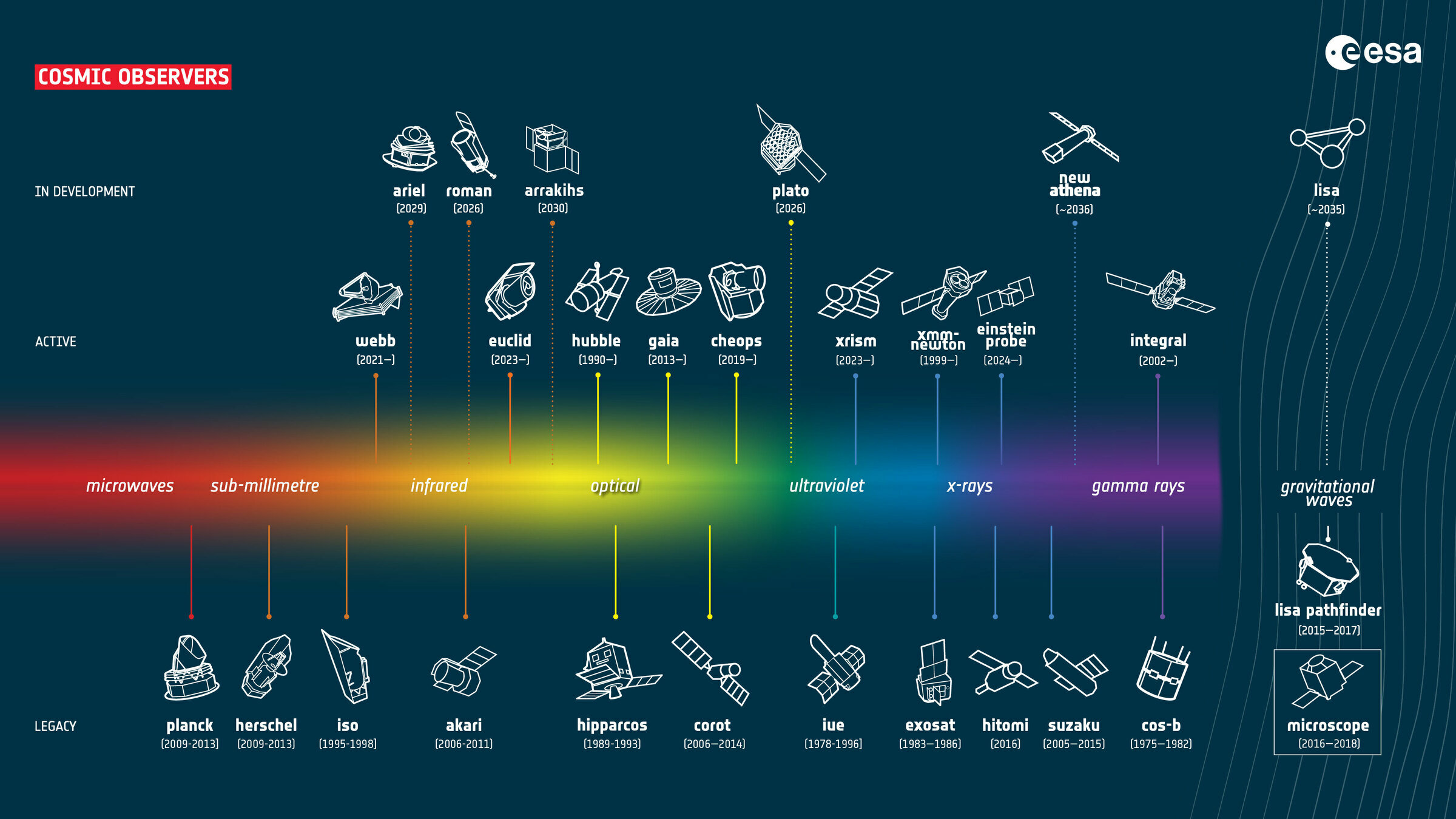
Lots of opportunities for outreach!!
Outreach
- Member of the Euclid Consortium Internal Communications team (ECICOM):
- Newsletter (+ J. Brinchmann, G. Cañas-Herrera): www.euclid-ec.org/science/newsletter/
- EC Education and Public Outreach member (ECEPO):
- Social media team, manager of @euclidconsortium instagram's account.
- Funding member of alpha-Cen : First Central-American association of astrophysics. Webinars, Remote-internships, mentoring, (Virtual) Summer Schools for underrepresented students .
- Podcasts : Podcastination (with CosmoStat members)
- Big Think, Starts with a Bang
- TV-appearances : Teleantioquia y Telemedellin
- CNRS 80-years anniversary: Euclid stand at Gif-Sur-Yvette.
- Science Communication Summer School: Alexander von Humboldt Foundation, Berlin, 2021.
Declaration handed in to German Bundestag, including chapters on inclusion and diversity.




Leverage opportunities at DAp and the mesmerising quality of its research (see D. Elbaz)

Take Home Message
Merci!
https://www.euclid-ec.org/public/press-releases/first-science-results-and-exclusive-ero-data/
-
Theoretical physicist and cosmologist, broad background, deep interests:
- computational physics, numerical methods, statistics, data analysis.
- computational physics, numerical methods, statistics, data analysis.
- Comprehensive and holistic understanding of the Euclid mission
- 10 years at forefront of Inter-Science-Working-Groups
- Competitive edge to exploit scientific content of the data and enable physical discoveries
- Extensive experience in supervision of research projects
- My skillset aligns, complements and potentiates fields of research of CosmoStat
- Can help CosmoStat/DAp lead and be at forefront of analysis of next generation cosmological experiments
Backup slides

Vera Rubin LSST
Square kilometer array (SKAO)


- Modelling is very analogous to GCsp, with brightness temperature on top and different biases
- GCsp-IM Cross-correlation in overlapping bins
- DESI : Two galaxy samples
- SKAO: HI Galaxies and 21cm-IM
\(P^{\rm IM}(z,k) = \bar{T}_{IM}(z)^2 \rm{AP}(z) K_{\rm rsd}^2(z, \mu; b_{\rm HI}) \)
\(FoG(z,k,\mu_\theta) \\ \times P_{\delta\delta,dw}(z,k) \)
\( K_{\rm rsd}(z, \mu; b_{\rm HI}) = [b_{\rm HI}(z)^2+f(z)\mu^2] \)
\( b_{\rm HI}(z) = 0.3(1+z) + 0.6 \)
\( \bar{T}_{\mathrm{IM}}(z)= 189h \frac{(1+z)^2 H_0}{H(z)}\Omega_{HI}(z) \,\,{\rm mK} \)
\(\Omega_{HI} = 4(1+z)^{0.6} \times 10^{-4} \)
Carucci et al (2020) 2006.05996
Jolicoeur et al (2020) 2009.06197
\(P^{{\rm IM} \times \rm{g}}(z,k) = \bar{T}_{\rm IM}(z) {\rm AP} (z) r_{\rm IM,opt} K_{\rm rsd}(z, \mu; b_{\rm HI}) \)
\( \times K_{\rm rsd}(z, \mu; b_{\rm g}) FoG(z,k,\mu_\theta) P_{\delta\delta,dw}(z,k) \)
\( \times \exp[-\frac{1}{2} k^2 \mu^2 (\sigma_{\rm IM}(z)^2+\sigma_{\rm sp}(z)^2)] \)
SC, Carucci, Pettorino et al (2022) 2210.05705
Brightness temperature of 21cm emission line
Fraction of neutral hydrogen in the Universe
Vera Rubin LSST
Radio x Optical Cosmology

SC, Carucci, Pettorino et al (2022) 2210.05705



- WL is better at measuring \(\Sigma\) (40% relative error)
- GC is better at measuring \(\mu\) (20% relative error)
- SKAO-all-probes constrains at 3-5% relative error
- At Planck best fits
- DESI(GCsp)xSKAO(IM) helps in \(h, \sigma_8\) but not in MG parameters
- Combination of SKAO + one Stage-IV probe is as good as two Stage-IV
- Different noise and systematics -> break degeneracies


Neutrinos



Neutrinos


Neutrinos



Neutrinos




Neutrinos

DESI



In a nutshell: Measure a geometric scale that was imprinted on LSS at recombination


https://data.desi.lbl.gov/doc/papers/
Another tension we need to explain?
spectroscopic probe: Full Shape
Linde, Moradinezhad, Rademacher, SC, Lesgourgues (2402.09778)

- Trade-off: larger error bars, more accuracy, less biasing
- Compared against IST:F model at different scales
- Many free parameters, good fit to ABACUS simulations


Tensions
Tensions IN \(\Lambda\)CDM

\(H_0\) tension at 5\(\sigma\)
- Tensions between local and sound-horizon-based measurements

Freedman et al
SH0ES, Riess et al
Planck 2018, VI


Tension with Planck in the
\(\sigma8\) - \(\Omega_m\) plane

Lange et al. arXiv: 2301.08692
- \( S_8 = \sigma_8 \sqrt{\Omega_{m,0}/0.3} \)
- So called "lensing is low" problem or S8 problem.
- At the moment just a discrepancy (no tension) at 2-3 \(\sigma\)
- Blind comparisons among surveys can rule out usual systematics below z<0.54 (A. Leauthaud et al.)
- Beyond \(\Lambda\)CDM modelling does not help with current nonlinear analysis
Planck 2018, VI

DES DRY3 arxiv:2207.05766
Tensions IN \(\Lambda\)CDM
Beyond Gaussian, non-Gaussianities



voids, filaments, walls, knots
Minkowski functionals
Bispectrum



Approximate Bayesian Compuation


Euclid's 3x2pt data vector:
~12200 entries long
30 ell-bins
13 n_z bins
GG, GL, LL



DELFI: Denisty estimation likelihood-free inference




Bayesian NN with Schafmeister

https://github.com/schafmeister/bayesian_nn


Stage V:



Backup slides